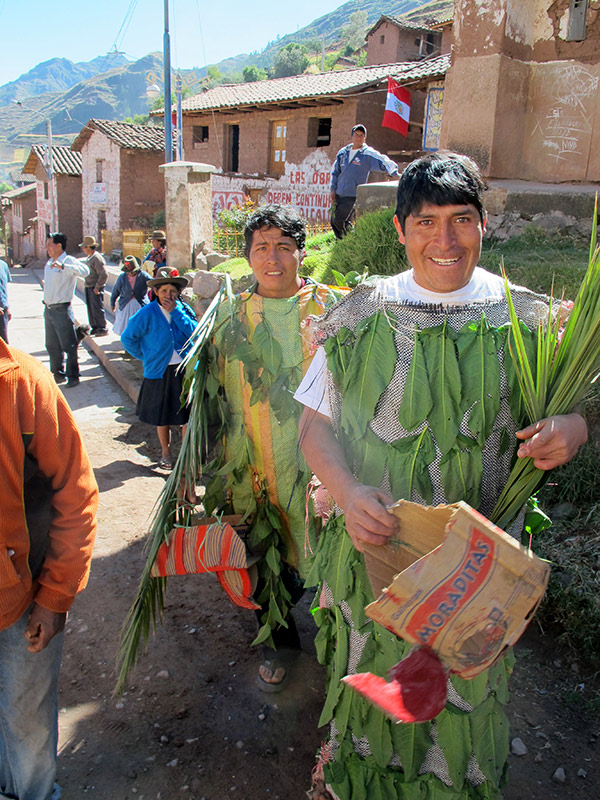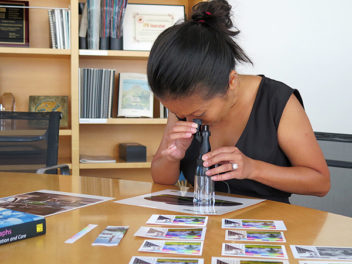
Interior of the Church of Kuño Tambo, Peru, showing some of its wall paintings
Isolated in the Peruvian Andes sits the adobe Church of Kuño Tambo, a 16th-century building made of a truss roof and thick adobe walls decorated with elaborate wall paintings. Due to a lack of maintenance, coupled with damage from seismic activity in the region, the structure of this historic building remains vulnerable and weak, its wall paintings damaged and unprotected.
Numerous significant earthen structures, their cultural heritage also threatened, exist throughout Latin America. As part of the effort to protect this earthen architecture, a project team from the Getty Conservation Institute (GCI) spent three weeks in June in Peru as part of the Seismic Retrofitting Project. This collaborative project between the GCI, University College London, Pontificia Universidad Católica del Perú, and the Ministerio de Cultura del Perú is part of the larger Earthen Architecture Initiative, which aims to further the conservation of earthen architecture.
I spoke to project manager Claudia Cancino and learned about her team’s work in the recent seismic retrofitting campaign. You can read Claudia’s account of her team’s earlier work here.
Thus far, the Conservation Institute project team and partners have examined four historic Peruvian buildings with the intent to develop guidelines for their seismic retrofitting. The Church of Kuño Tambo (shown in photo below), as well as the Hotel El Comercio, Ica Cathedral, and Casa Arones, were chosen as prototypes for this project because of their similarity to other buildings found in seismic regions throughout Latin America.

Detail of wall paintings in the Church of Kuño Tambo, Peru
During the most recent campaign, the majority of work focused on the Church of Kuño Tambo. The team, which included documentation experts from Carleton University, conducted assessments of the wall paintings in the church in order to determine their condition and develop protective methods that could be used during the process of retrofitting the building.

Claudia Cancino (standing) meets with representatives from the Peruvian Ministry of Culture
A significant outcome of the last campaign, Claudia told me, is the newfound collaboration between the Conservation Institute project team and professionals from the regional office of the Peruvian Ministry of Culture in Cusco. Now, she says, these colleagues are “engaged in our work, and that’s one of the things we always want to do: to work with local professionals on site.”


The Seismic Retrofitting Project has forged closer ties with the Ministry of Culture. During the last campaign, the village of Kuño Tambo celebrated the first-time visit from the Ministry of Culture, represented at that time by Dr. Luis Peirano (meeting with Claudia in the top photo above).
Initially, the plan was for Claudia’s team to create guidelines that could be referenced by others when retrofitting historic earthen buildings, and potentially to implement these techniques on one of the prototype buildings as a model project. With the Peruvian government’s increased support, Claudia’s team will now be able to apply the techniques they develop to not one, but two prototype structures: the Church of Kuño Tambo and Ica Cathedral. Claudia told me she’s optimistic about this new development. “Now, instead of having one project, [the team] has two. It’s not that the objective has changed, but that other objectives have been added.”
The Conservation Institute’s goal in this project is to contribute to the seismic retrofitting of earthen buildings by proving “scientifically, with tested data, that some of the traditional techniques that have been used [to retrofit] are still valid,” Claudia explained. “The data gathered can be used to run calculations to develop building-specific retrofitting techniques.”
The final objective of the Seismic Retrofitting Project will be to apply the new guidelines to other sites so that “the techniques not only serve the retrofitting of the [prototypes], but also can be adapted to other buildings.”
Claudia hopes this work will forward the preservation of the cultural heritage of Latin America and other regions of the world that have both earthen architecture and earthquakes. Her team is in Peru for another three weeks, working closely with the Peruvian government to continue study and analysis of the four prototype buildings.
The GCI’s work at Kuno Tambo is generously supported by the Friends of Heritage Preservation.




Comments on this post are now closed.